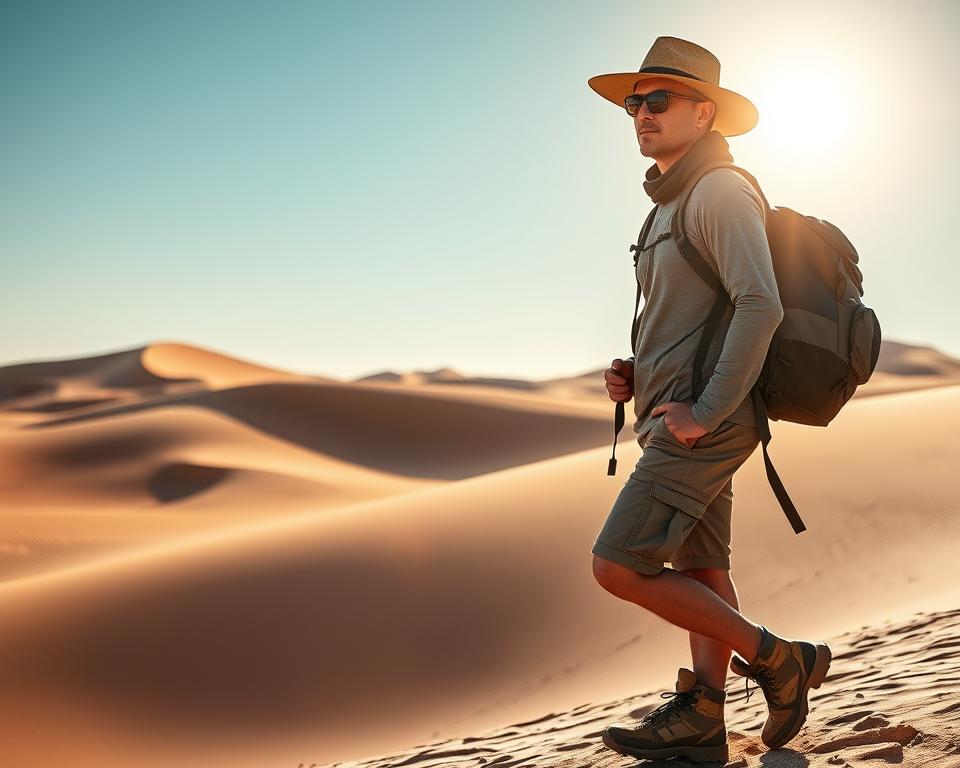Going on a desert hike is thrilling but challenging. The extreme heat during the day and cold at night, along with harsh sunlight, means you need to choose your clothes wisely. Not only for comfort but for safety too. Whether it’s Zion National Park or another desert spot, picking the right gear is crucial.
Desert temperature swings are intense. Daytime can be scorching, and nights might cool down by over 30°F. That’s why layering light, breathable fabrics is key. Choose materials like moisture-wicking polyester or Merino wool. They regulate temperature and keep you dry. Avoid cotton since it keeps moisture close to your body.
Wear sun-protective clothing, too. Look for items with a UPF rating of 30 or more. This protects against the sun’s harmful rays. Convertible pants and vented shirts are great for staying cool. And remember, clothes with breathable features are super important for your comfort while hiking.
Besides clothes, don’t forget essential accessories for full sun protection. Wide-brimmed hats, sunglasses with UV protection, and neck gaiters are must-haves. Choosing the right gear makes your hike better and safer. You’ll be more comfortable and protected on your journey.
Understanding Desert Weather Conditions
Before you hike in the desert, know its unique weather patterns. The desert has beautiful scenes but also tough conditions for hikers. We’ll look at two key things hikers should know: temperature changes and wind with storms.
Temperature Fluctuations
The desert is known for extreme temperature changes, especially between day and night. For example, Zion National Park’s summer days can hit 100°F (38°C), and nights can be 30 degrees cooler. These big shifts affect hiker comfort and safety, so getting ready for your hike is crucial.
Wearing light layers helps you adjust to these conditions. During the day, light-colored, breathable clothes keep you cool by reflecting the sun. At night, extra layers keep you warm as the temperature drops.
Wind and Storms
The desert weather also brings unpredictable wind and storm activity. Strong winds can stir up dust and sand, making it hard to see and unpleasant. During the monsoon season in July and August, storms can suddenly appear and cause dangerous flash floods. This is especially true in slot canyons.
To hike safely and enjoyably in the desert, knowing these weather patterns is key. Preparing for your hike is important. This way, hikers can admire the desert’s beauty while being safe and comfy.
Choosing the Right Fabrics
When you plan a desert hike, choosing the right clothing fabrics is important. They greatly affect your comfort and safety. Ideal fabrics should manage moisture, allow air flow, and regulate temperature.
Let’s look at the good and bad sides of some favorite hiking fabrics.
Cotton
Cotton’s role in outdoor clothes is often debated. On one side, it feels cool and refreshing when damp. Yet, it can get heavy and uncomfortable if wet. This makes it less ideal for cool nights in the desert.
However, depending on your hike’s conditions, cotton might still have benefits. It’s all about managing sweat and temperature.
Polyester
Polyester is loved for moving moisture away from the body. It’s light, dries fast, and is great for desert walks. Plus, it’s strong and keeps up well with tough ground.
But, it might hold onto body smells on long trips. Even so, its benefits for keeping you dry and comfortable are well noted. That’s why many hikers prefer it.
Merino Wool
Merino wool is a top pick for desert adventuring. Its fibers are fine and bend easily. This means it feels really soft and comfy.
It’s also great at controlling your body’s temperature. It keeps you warm in the cold and cools you down when it’s hot. With its ability to resist smells, it’s excellent for longer treks.
This blend of moisture management and comfort puts Merino wool high on the list. That’s why many desert hikers choose it.
Best Hiking Clothes for Desert Hiking
Desert hiking calls for the right clothes for safety and comfort. You’ll face extreme temperatures and tough conditions. So, clothes that use the latest outdoor tech are a must. Look for lightweight layers, breathable fabrics, and UV protection in your hiking gear.
Lightweight Layers
Using layers helps handle changing temperatures in the desert well. For example, daytime and nighttime temperatures at Zion National Park can vary by over 30°F. Having lightweight layers lets you adapt without feeling weighed down.
Merino wool base layers are perfect for staying warm on cool nights. For the day, consider KÜHL’s Renegade Cargo Convertible pants. They’re lightweight and come with UPF 50 sun protection.
Breathable Features
When you’re in the desert, it’s important your clothes can breathe. The heat makes you sweat, which can then evaporate quickly. This might make you dehydrated.
Wear made from polyester is water-resistant, dries quickly, and keeps warmth. KÜHL’s Airspeed LS shirt includes mesh panels. These provide better airflow and UPF 30 protection. They help keep you cool and safe from the sun.
Sun Protective Clothing
Protecting yourself from the sun’s rays is crucial during long hikes. Wear clothes marked with sun protection like hats, pants, and shirts. They protect well against UV rays. For cooler wear, choose light colors like white or beige.
The Sun Blade Hat by KÜHL gives shade and UPF 50 protection. A lightweight jacket such as the Transcendr Hoody shields you from sun and sudden rain.
For more info on desert hiking clothes, check this detailed guide at desert hiking clothing essentials. It has all you need to know for your next desert adventure.
Essential Accessories for Sun Protection
Heading out for a desert hike means you need to protect yourself from the sun. It’s important to pick the right accessories for UV protection. These items are key for your safety and comfort outdoors.
Wide-Brimmed Hats
A wide-brimmed hat is a must-have for hiking. The KÜHL Sun Blade, with its UPF 50 protection, shields your face and neck. I love the Wallaroo Sedona for both its excellent sun protection and stylish look.
Sunglasses
Your eyes need safeguarding too, and sunglasses are essential. They protect from UV rays and cut down glare. Make sure your sunglasses have UV protection to keep your eyes safe on your journey.
Neck Gaiters and Bandanas
Neck gaiters and bandanas offer great UV protection. They protect from the sun and dust. Wet them for a cooling effect. The Buff is versatile. It can cover your neck, mouth, and nose, or be a headband. It offers a handy way to tackle sun exposure.
What Clothing Should I Wear for a Safe Hike in Desert Conditions?
When hiking safely in the desert, opt for lightweight, breathable fabrics that wick moisture away from your skin. Long-sleeved shirts and long pants are essential to protect against the sun and thorny plants. Don’t forget a wide-brimmed hat, sunglasses, and sturdy hiking boots to enhance your comfort and safety.
Conclusion
Desert hiking offers a rewarding experience, but it requires good preparation. The desert has big temperature changes, from hot days to cool nights. This means you need gear that can handle both. Choosing materials like polyester for drying, cotton for its coolness, and merino wool for comfort is smart.
Wearing clothes that protect you in the desert is crucial. For example, the KÜHL Renegade Cargo Convertible pants and the Airspeed LS shirt protect from the sun. Light and breathable gear, such as shirts and the Transcendr Hoody rain jacket, keep you cool. Also, a Sun Blade hat and polarized sunglasses are important for protection.
To do well in desert hiking, you must prepare well and be ready for surprises. Pick the right shoes, like those from Merrel or Salomon, and socks that help with sweat. High-quality, sun-protecting gear makes hiking safer and more enjoyable. Get ready to explore the beautiful, tough desert with the right equipment.

